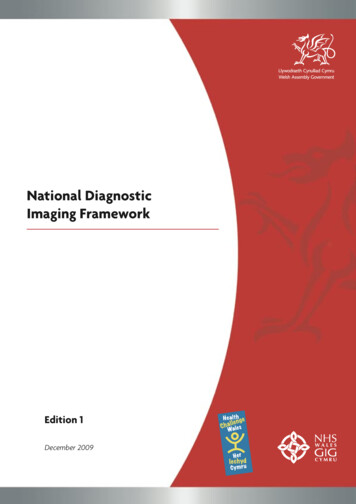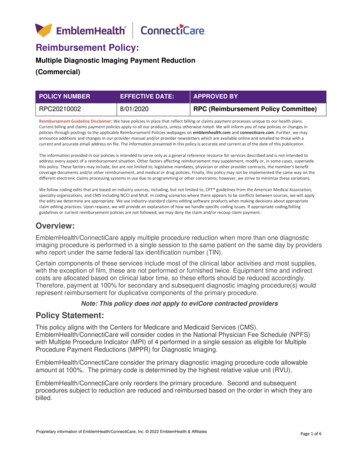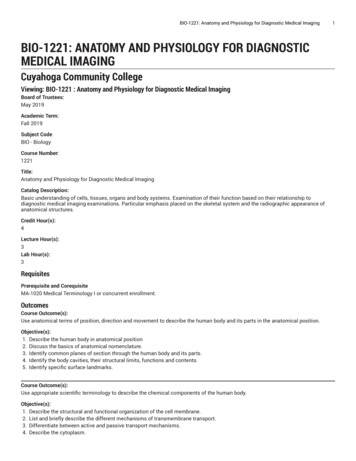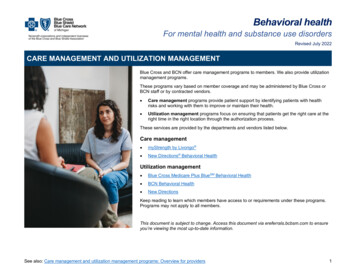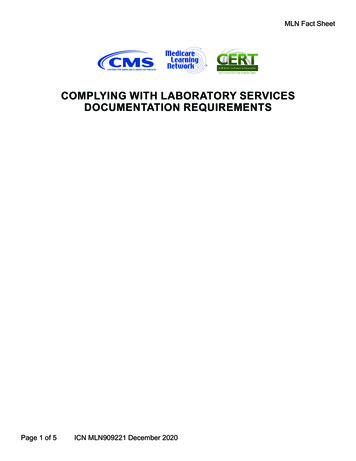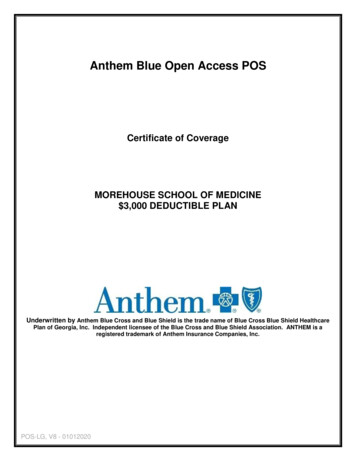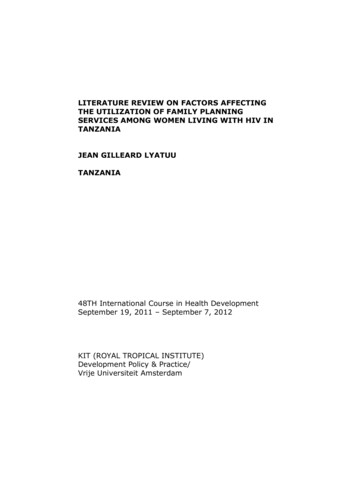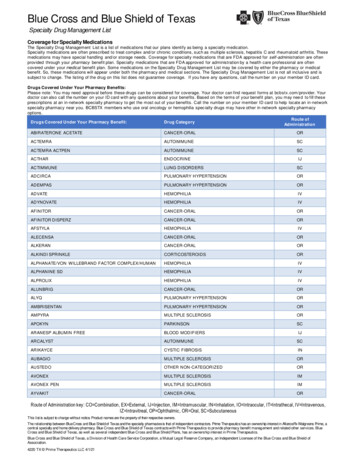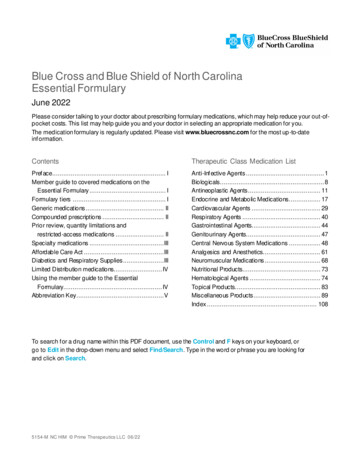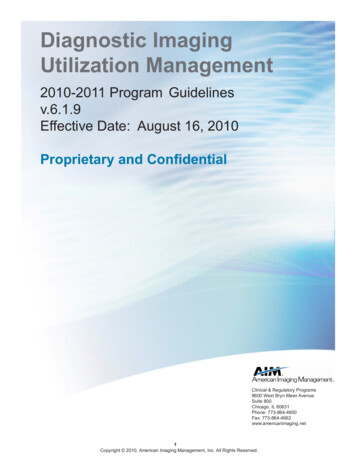
Transcription
Diagnostic ImagingUtilization Management2010-2011 Program Guidelinesv.6.1.9Effective Date: August 16, 2010Proprietary and ConfidentialClinical & Regulatory Programs8600 West Bryn Mawr AvenueSuite 800Chicago, IL 60631Phone: 773-864-4600Fax: 773-864-4662www.americanimaging.net1Copyright 2010, American Imaging Management, Inc. All Rights Reserved.
Table of ContentsUse of AIM’s Diagnostic Imaging GuidelinesUse of AIM’s Diagnostic Imaging Guidelines. 4Administrative Guidelines. 5Guideline: Simultaneous Ordering Of Multiple Imaging Tests. 6Head & Neck ImagingCT of the Head. 8CTA of the Head: Cerebrovascular. 14MRI of the Head. 17MRA of the Head: Cerebrovascular. 23Functional Brain MRI. 26PET Brain Imaging. 28CT of theOrbit, Sella Turcica, Posterior Fossa and the Temporal Bone, including Mastoids. 30MRI of the Orbit, Face, Neck. 33CT of the Paranasal Sinus Maxillofacial Area. 36MRI of the Temporomandibular Joints. 39CT of the Neck (Soft Tissue). 41CTA of the Neck. 43MRA of the Neck. 46Chest ImagingCT of the Chest. 49CTA of the Chest. 54MRI of the Chest. 58MRA of the Chest. 61MRI of the Breast. 65Cardiac ImagingNuclear Cardiology - Myocardial Perfusion Imaging. 68Nuclear Cardiology - Cardiac Blood Pool Imaging. 75Nuclear Cardiology - Infarct Imaging. 79Stress Echocardiography. 81Transesophageal Echocardiography (TEE). 88Resting Transthoracic Echocardiography (TTE). 90CT Cardiac (Structure). 98CCTA Coronary Artery. 102CT - Evaluation of Coronary Calcification. 1052Copyright 2010, American Imaging Management, Inc. All Rights Reserved.
MRI - Cardiac. 107PET Myocardial Imaging.112Abdominal & Pelvic ImagingCT of the Abdomen.114MRI of the Abdomen. 120CTA/MRA of the Abdomen. 124CTA of the Abdominal Aorta - Lower Extremity Run-off. 128CT of the Pelvis. 130MRI of the Pelvis. 135CTA/MRA of the Pelvis. 139CT of the Abdomen & Pelvis Combination. 142CT Colonography. 147Spine ImagingCT of the Cervical Spine. 149MRI of the Cervical Spine. 152CT of the Thoracic Spine. 155MRI of the Thoracic Spine. 158CT of the Lumbar Spine. 161MRI of the Lumbar Spine. 164MRA of the Spinal Canal. 168Upper Extremity ImagingCT of the Upper Extremity. 169MRI of the Upper Extremity (Any Joint). 171MRI of the Upper Extremity (Non-Joint). 176CTA/MRA Upper Extremity. 179Lower Extremity ImagingCT of the Lower Extremity. 181MRI of the Lower Extremity (Joint & Non- Joint). 183CTA/MRA of the Lower Extremity. 188PET Imaging - Other Including OncologicPET - Other PET Applications Including Oncologic Tumor Imaging. 191OtherMagnetic Resonance Spectroscopy (MRS). 200MRI - Bone Marrow Blood Supply. 201Quantitative CT - Bone Mineral Densitometry. 2033Copyright 2010, American Imaging Management, Inc. All Rights Reserved.
Clinical GuidelinesWebsite DisclaimerBY ACCEPTING THESE DOCUMENTS, I ACKNOWLEDGE ACCEPTANCE OF THE FOLLOWING TERMS AND CONDITIONS FOR ACCESS AND USE OF THE CLINICAL GUIDELINES:American Imaging Management, Inc. (AIM) has developed proprietary Diagnostic ImagingUtilization Management Clinical Guidelines (together with any updates, referred to collectively as the “Guidelines”). The Guidelines are designed to evaluate and direct the appropriate utilization of high technology diagnostic imaging services. They are based on data fromthe peer-reviewed scientific literature, from criteria developed by specialty societies and fromguidelines adopted by other health care organizations. Access to these Guidelines is beingprovided for informational purposes only. AIM is under no obligation to update its Guidelines. Therefore, these Guidelines may be out of date.The Guidelines are protected by copyright of AIM as permitted by and to the full extent of thelaw. These rights are not released, transferred, or assigned as a result of allowing access.You agree that you do not have any ownership rights to the Guidelines and you are expresslyprohibited from selling, assigning, leasing, licensing, reproducing or distributing the Guidelines, unless authorized in writing by AIM.The Guidelines do not constitute medical advice and/or medical care, and do not guaranteeresults or outcomes. The Guidelines are not a substitute for the experience and judgmentof a physician or other health care professionals. Any clinician seeking to apply or consultthe Guidelines is expected to use independent medical judgment in the context of individualclinical circumstances to determine any patient’s care or treatment. The Guidelines do notaddress coverage, benefit or other plan specific issues.The Guidelines are provided “as is” without warranty of any kind, either expressed or implied.AIM disclaims all responsibility for any consequences or liability attributable or related to anyuse, non-use or interpretation of information contained in the Guidelines.4Copyright 2010, American Imaging Management, Inc. All Rights Reserved.
AIM’s Practice Guidelines Define the Optimal approaches for DiagnosticImaging Utilization during Individualized Case ReviewUse of AIM’s Diagnostic Imaging Guidelines:AIM’s Proprietary Clinical Practice Guidelines are designed to evaluate and direct the appropriate utilization ofelective, high technology diagnostic imaging services. In the process, multiple functions are accomplished: To promote the most efficient and cost-effective use of diagnostic imaging services To assist the practitioner as an educational tool To encourage standardization of medical practice patterns and reduce variation in clinical evaluation To curtail the performance of inappropriate, elective diagnostic imaging studies To reduce the performance of duplicative diagnostic imaging studies To advocate biosafety issues, including unnecessary radiation exposure (for CT and plain film radiography) and MRI safety concerns To enhance quality of healthcare for elective diagnostic imaging studies, using evidence-based medicineand outcomes research from numerous resourcesAIM Guideline Development Process and Resources:The development of AIM’s proprietary practice guidelines involves integration of medical information from multiple sources, to support the reproducible use of high quality and state-of-the-art advanced diagnostic imagingservices. The process for criteria development is based on technology assessment, peer-reviewed medicalliterature including clinical outcomes research and consensus opinion in medical practice.The primary resources used for AIM guideline development include: American College of Radiology (ACR) Appropriateness Criteria American College of Cardiology (ACC) Appropriateness Criteria American Heart Association (AHA) American Institute of Ultrasound in Medicine (AIUM) American Cancer Society (ACS) American Academy of Neurology (AAN) American Academy of Pediatrics (AAP) Society of Interventional Radiology (SIR) Society of Nuclear Medicine (SNM) Agency for Healthcare Research and Quality (AHRQ) National Guideline Clearinghouse Centers for Medicare and Medicaid Services (CMS) * When variances occur Medicare NCD and LCD determinations will be used instead of AIM guidelines for medicare advantage patientsGuideline review:AIM’s proprietary guidelines for appropriate diagnostic imaging utilization are reviewed routinely by:1.Independent Physician Review Board: AIM’s Physician Specialty Advisory Panel2.Health Plan Medical Directors3.Local Imaging Advisory Council (representing local physician communities)4.Physician Review Panels, under the governance of our clients’ State Regulatory Agencies5Copyright 2010, American Imaging Management, Inc. All Rights Reserved.
Guideline: Simultaneous Orderingof Multiple Imaging TestsModality: ALLBody Part: ALLCPT Codes: ALLSTANDARD ANATOMIC COVERAGE:The major area of concern is contiguous body parts where clinical signs and symptoms may be coming from abnormalitiesinvolving either region, or different modalities can be considered to evaluate the same anatomy for the same clinicalproblem. These are areas where ordering multiple tests before the results of any of the tests are known lead to inappropriateimaging.GENERAL CONSIDERATIONS:Rapid breakthroughs in technology, with attendant rise of new imaging tests available to improve patient management, havecreated a dilemma for clinicians. Many factors in choosing the right test now come into play. One must consider basic data inthe decision-making process. Considerations include the possible effect on patient management, the pretest probability thatthe patient is affected by a particular disease, the prevalence of the disease in the population, and the accuracy [sensitivity\specificity] of the test. When a screening approach is adopted, rather than targeting the particular test or anatomic site withthe highest pretest probability of success, the possibility of one or more of the tests being superfluous and not contributingmeaningfully to patient management increases to an unacceptable level.For this reason, simultaneous ordering of multiple examinations may subject these examinations to more intensivelevels of review than would be the case if these same tests were ordered sequentially. Depending on the clinicalsituation, one or more of the requested studies might not meet medical necessity criteria until the results of thelead study are known.COMMON DIAGNOSTIC INDICATIONS FOR MULTIPLE SIMULTANEOUS IMAGING REQUESTS: The initial diagnosis/staging or follow-up of oncology patients Follow-up of patients who have had operative procedures on multiple anatomic sites Patients in whom the suspected anatomic abnormality might extend into multiple regions, such as diverticulitis or suspected syringomyeliaCOMMON INAPPROPRIATE MULTIPLE SIMULTANEOUS IMAGING REQUESTS: Brain MRA ordered routinely with brain MRI without vascular indications Brain CT ordered simultaneously with sinus CT for headache Multiple levels of spine MRI’s or CT’s for diffuse back pain or radicular symptoms Cervical spine and shoulder MRI’s ordered simultaneously for shoulder pain Pelvic or hip MRI’s ordered simultaneously with lumbar spine MRI for hip pain Pelvic CT ordered routinely with abdominal CT for suspected upper quadrant disease processesREFERENCE/LITERATURE REVIEW:1.Kuhns M. D., Lawrence R., Thornberry M.D., John R., Freyback Ph.D., Dennis, Decision-making Imaging. YEARBOOK medicalpublishers 19892.Duboulet M. D., Ph.D., Peter M. Cain, Ph.D. Kevin C. The Superiority of Sequential over Simultaneous Testing,.Medical decisionmaking volume 5 NUMBER 4 PAGES 447 – 451, 19853.Fryback, Ph.D. Dennis G., Thornberry, M.D. John R. The Efficacy of Diagnostic Imaging. Medical Decision-Making, volume 11,number two, pages 88 – 94, 19916Copyright 2010, American Imaging Management, Inc. All Rights Reserved.
REFERENCE/LITERATURE REVIEW:4.Hollingsworth W. and Jarvik J. G. Technology Assessment in Radiology: Rutting the Evidence in Evidence-Based Radiology.Radiology,: 244 (1) PAGES 31-38, July 1, 20075.Analysis of Diagnostic Confidence and Diagnostic Accuracy: a Unified Framework. British Journal of Radiology, March 1, 2007; (951):pages 152-1606.Dodd J. D. Radiology, Evidence-based Practice in Radiology: Steps Three and Four-Appraise and Apply Diagnostic RadiologyLiterature. 242 (2): pages 342- 354, February 1, 2007;7.Comparative Accuracy: Assessing New Tests Against Existing Diagnostic Pathways. British Medical Journal May 6, 2006; 332(7549):pages 1089-10927Copyright 2010, American Imaging Management, Inc. All Rights Reserved.
Computed Tomography (CT)HeadCPT CODES:70450.CT of Head, without contrast70460.CT of Head, with contrast70470.CT of Head, without contrast, followed by re-imaging with contrastSTANDARD ANATOMIC COVERAGE: From the skull base to vertex, covering the entire calvarium and intra-cranial contents. Scan coverage may vary, depending on the specific clinical indication.IMAGING CONSIDERATIONS: Radiation Dosimetry: CT of Head, either without or with contrast, has a typical effective dose of approximately 2.3 milliSieverts (mSv) or 115 Chest X-Ray equivalents. MRI of the head is preferable to CT in most clinical scenarios, due to its superior contrast resolution and lack of beamhardening artifact adjacent to the petrous bone (which may limit visualization in portions of the posterior fossa andbrainstem on CT). Notable exceptions to the use of head MRI as the neuroimaging procedure of choice are: acuteintra-cranial hemorrhage (parenchymal, subarachnoid; subdural; epidural); initial evaluation of recent craniocerebraltrauma; osseous assessment of the calvarium, skull base and maxillofacial bones, including detection of calvarial andfacial bone fractures; and evaluation of calcified intracranial lesions. CT of the head is an alternative exam in patients who cannot undergo MRI. Ordering and imaging providers areresponsible for considering biosafety issues prior to MRI examination, to ensure patient safety. Among the generallyrecognized contraindications to MRI exam performance are indwelling pacemakers or implantable cardioverter-defibrillators (ICD), intracranial aneurysm surgical clips that are not compatible with MR imaging, as well as other devicesthat are unsafe in MRI scanners (including implanted materials in the patient as well as external equipment, such asportable oxygen tanks). Contrast-enhanced CT may be contraindicated in certain circumstances, such as a documented allergy to intravenouscontrast material and renal insufficiency. Special consideration should also be given to patients with multiple myeloma. For CT imaging of the orbits, internal auditory canals (IACs) or temporal bones, see CPT codes 70480-70482. According to Medicare’s Correct Coding Edits, a CT of the Head is not usually performed with a CT of the Orbits.These studies are generally considered mutually exclusive procedures. Imaging studies of the head and neck are inherently bilateral. Duplicate requests for bilateral studies to image the rightand left side of the head are inappropriate. Duplicative testing or repeat imaging of the same anatomic area with same or similar technology may be subject tohigh-level review and may not be medically necessary unless there is a persistent diagnostic problem or there hasbeen a change in clinical status (e.g. deterioration) or there is a medical intervention which warrants interval reassessment. Request for re-imaging due to technically limited exams is the responsibility of the imaging providers.COMMON DIAGNOSTIC INDICATIONS FOR HEAD CT:The following diagnostic indications for Head CT are accompanied by pre-test considerations aswell as clinical supporting data and prerequisite information:CT is the imaging modality of choice for evaluation of: Acute intra-cranial hemorrhage (parenchymal, subarachnoid, subdural and epidural hematomas); Recent head trauma; Osseous evaluation of the calvarium, skull base and facial bones, including detection of calvarial and facial bone fractures as well as assessment of the temporal bones for conductive hearing loss and an abnormal otoscopic exam;8Copyright 2010, American Imaging Management, Inc. All Rights Reserved.
COMMON DIAGNOSTIC INDICATIONS FOR HEAD CT: Calcified lesions MRI is the preferred technique for most other indications, unless contraindicated. 1-2 This includes assessment of thecerebral parenchyma, cerebellum, brainstem and pituitary gland.ABNORMALITIES DETECTED ON OTHER IMAGING STUDIES WHICH REQUIRE ADDITIONAL CLARIFICATION TODIRECT TREATMENTCNS FINDINGS/DEFICITS – NEW ONSET OR PROGRESSIVELY WORSENING NEUROLOGICAL ABNORMALITY Including but not limited to the following clinical symptoms and findings:–– Anosmia (loss or impairment in sense of smell)–– Ataxia (inability to coordinate voluntary muscular movements)–– Bell’s Palsy 3–– Dysgeusia (dysfunction in sense of taste)–– Facial Numbness–– Gait Disorder–– Other Movement Disorders–– Nystagmus (rapid, involuntary, oscillating ocular movements)–– Paresis or Paralysis–– Tinnitus (ringing or roaring auditory sensation; may be either unilateral or bilateral; pulsatile or non-pulsatile; transient or persistent) 4–– Other cranial nerve impairmentNote: Contrast-enhanced MRI, unless contraindicated, is generally recommended for evaluation of cranial nerveimpairment.CEREBROVASCULAR ACCIDENT (CVA OR STROKE) AND TRANSIENT ISCHEMIC ATTACK (TIA) 5-6 May present with a variety of signs and symptoms, including sudden onset of weakness, focal sensory loss or speechdisorder Among patients being evaluated for CVA and possible thrombolytic therapy, unenhanced CT is often performed as theinitial modality (within the initial 24 hours after symptom onset), to detect a possible hemorrhagic stroke or mass lesion.CONGENITAL ANOMALY 7 Including but not limited to the following conditions:–– Chiari Malformations–– Dandy-Walker Spectrum–– Encephalocele–– Holoprosencephaly–– Macrocephaly–– Microcephaly–– Schizencephaly–– Septo-optic DysplasiaCRANIOSYNOSTOSISDEMENTIA 8-9 Initial evaluation, if MRI is contraindicated, or Rapid progression, if MRI is contraindicatedDEVELOPMENTAL DELAY 10 In developmental delay, MRI is the preferred imaging modality over CT The likelihood of making a specific neuroimaging diagnosis increases in the presence of physical exam abnormalitiessuch as focal motor findings or microcephalyEVALUATION OF ABNORMAL FINDINGS DETECTED ON OTHER IMAGING STUDIES - SUCH AS A MASS LESION ORABNORMAL INTRACRANIAL CALCIFICATION9Copyright 2010, American Imaging Management, Inc. All Rights Reserved.
COMMON DIAGNOSTIC INDICATIONS FOR HEAD CT:HEADACHE IN ADULT – WHEN ANY ONE OF THE FOLLOWING CRITERIA ARE MET:11 Sudden onset and severe, including thunderclap or worst headache of life; or Increased frequency and severity; or With new focal neurologic signs, particularly papilledema, visual field defects and nuchal rigidity; or New-onset headaches after age 50 years, as a recommendation; age is not an absolute requirement; or New-onset headaches in cancer or immunodeficient patient; or With mental status changes; or With fever, nuchal rigidity and other meningeal signs; or With nausea and vomiting; or With exertion; or Frequently awakened from sleepNote: Current evidence does not support CT evaluation for chronic headache or migraines, when the patient’s neurologicalstatus is unchanged.HEADACHE IN PEDIATRIC PATIENT – WHEN ANY ONE OF THE FOLLOWING CRITERIA ARE MET:11-13 Sudden onset and severe, including thunderclap or worst headache of life; or Associated with neurological abnormalities such as nystagmus, papilledema, gait or motor disturbances; or With fever, nuchal rigidity and other meningeal signs; or Awakened repeatedly from sleep or develop upon awakening; or Persistent headache with confusion, disorientation or vomiting; or Persistent headaches of 6 months duration and not responsive to medical treatment; or Persistent headaches, without a family history of migraines; or Familial or personal history of disorders with predisposition to CNS lesions and clinical/laboratory findings that suggestCNS involvement;HEMORRHAGE/HEMATOMA Refers to non-traumatic, non-CVA and non-tumor-related intra-cranial bleed. Examples include hypertensive hemorrhage and hemorrhage secondary to anti-coagulation or blood dyscrasia CT is the preferred technique for evaluation of acute intra-cranial hemorrhage 14-15 MRI is usually preferred for evaluation of subacute and chronic hemorrhageHYDROCEPHALUS (VENTRICULOMEGALY) MRI is often the preferred for initial evaluation of patients with hydrocephalus. For patients with an indwelling shunt, CTis usually adequate in the diagnostic follow-up of hydrocephalus.INCREASED INTRACRANIAL PRESSURE OR HERNIATIONINFECTIOUS OR INFLAMMATORY PROCESS 16 Including but not limited to the following:–– Cerebral or Cerebellar Abscess–– Encephalitis–– Meningitis–– Neurocysticercosis–– Opportunistic Infection, particularly with immunosuppressed or other immunodeficient conditions–– Subdural EmpyemaMENTAL STATUS CHANGES, WITH DOCUMENTED OBJECTIVE EVIDENCE FROM NEUROLOGIC EXAMMOVEMENT DISORDERS Including Parkinson’s disease (particularly atypical cases with poor response to levodopa, in which there may be anunderlying structural disorder producing parkinsonian features); Huntington’s disease; idiopathic sporadic cerebellarataxia (olivopontocerebellar atrophy); and other conditions.10Copyright 2010, American Imaging Management, Inc. All Rights Reserved.
COMMON DIAGNOSTIC INDICATIONS FOR HEAD CT:MULTIPLE SCLEROSIS AND OTHER WHITE-MATTER DISEASES, WHEN MRI IS CONTRAINDICATED OR NOTTOLERATED 17 Initial diagnosis; or periodic scans to assess asymptomatic progression in multiple sclerosis during the early course ofdisease; or tracking the progress of multiple sclerosis to establish a prognosis or evaluation of response to treatment;or to evaluate changes in neurologic signs and symptoms; or to assess for asymptomatic progression early in thecourse of the disease if this information would be used to make treatment determinationNEUROCUTANEOUS DISORDERS Including but not limited to the following:–– Neurofibromatosis–– Sturge-Weber Syndrome–– Tuberous Sclerosis–– Von Hippel-Lindau Disease (VHL)NEUROENDOCRINE ABNORMALITY SUGGESTIVE OF A PITUITARY LESION MRI is usually preferred over CT for evaluation of pituitary lesions Relevant laboratory and clinical abnormalities are requiredPAPILLEDEMA (refers to swelling and elevation of optic disc – a sign of increased intracranial pressure)PRE- AND POST-NEUROSURGICAL EVALUATIONPRIOR TO LUMBAR PUNCTURESEIZURE DISORDER – new onset or increasing frequency and severity 18SENSORINEURAL HEARING LOSS, DOCUMENTED BY AUDIOLOGY As work-up for Acoustic Neuroma (Vestibular Schwannoma) – also see Primary Intra-cranial TumorsNote: Contrast-enhanced MRI, unless contraindicated, is generally recommended for evaluation of sensorineural hearingloss.SYNCOPE 19 Syncope (partial or complete loss of consciousness) and near syncope (lightheadedness) are infrequently of primaryneurological origin, particularly in the absence of abnormal neurological findings. Neurological consultation (for assessment of possible vertebrobasilar TIAs) and cardiovascular evaluation should beconsidered.TRAUMA TO HEAD 20-21 CT is usually preferred for the initial evaluation of acute head trauma, due to the high sensitivity for hemorrhage andability to display fractures Particularly when associated with:–– Calvarial fracture (as demonstrated on plain film radiography)–– Change in Mental Status or Amnesia–– Focal Neurological Deficits–– Loss of Consciousness–– Seizures–– Signs of Increased Intracranial Pressure–– Nausea / Vomiting–– Worsening Headaches Suspected hemorrhage, or subdural or epidural hematomaTUMOR EVALUATION – BENIGN AND MALIGNANT: 22Including but not limited to the following lesions: Primary Intra-cranial Tumors1. Intra-axial Neoplasms of the Cerebrum and Cerebellum11Copyright 2010, American Imaging Management, Inc. All Rights Reserved.
COMMON DIAGNOSTIC INDICATIONS FOR HEAD CT:2.Extra-axial Tumors, including Meningiomas and Schwannomas, such as:–– Cerebello-pontine Angle (CPA) and internal auditory canal (IAC) Vestibular Schwann
American Imaging Management, Inc. (AIM) has developed proprietary Diagnostic Imaging Utilization Management Clinical Guidelines (together with any updates, referred to collec-tively as the "Guidelines"). The Guidelines are designed to evaluate and direct the appropri-ate utilization of high technology diagnostic imaging services.
